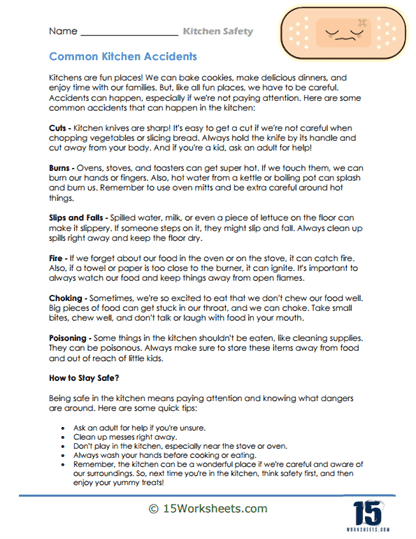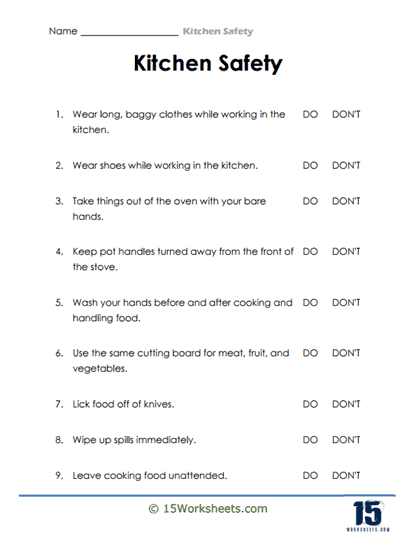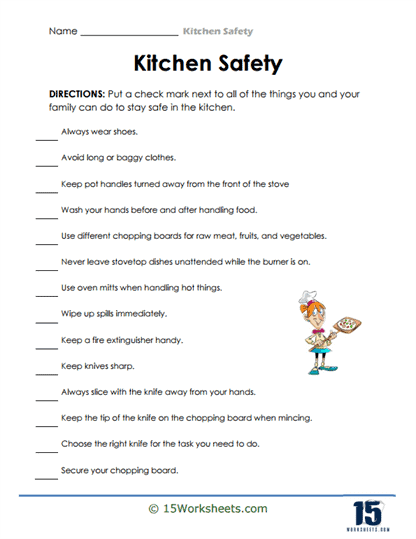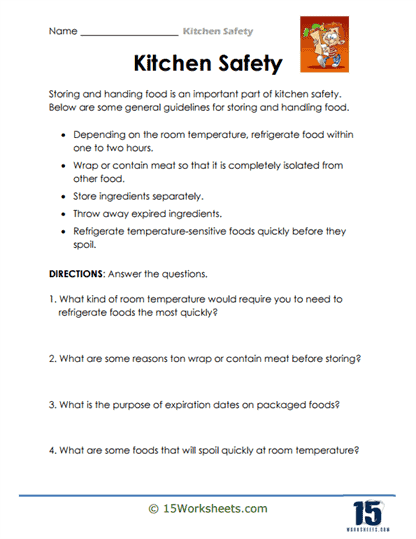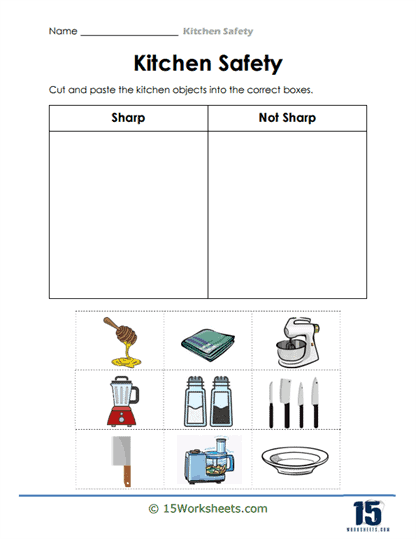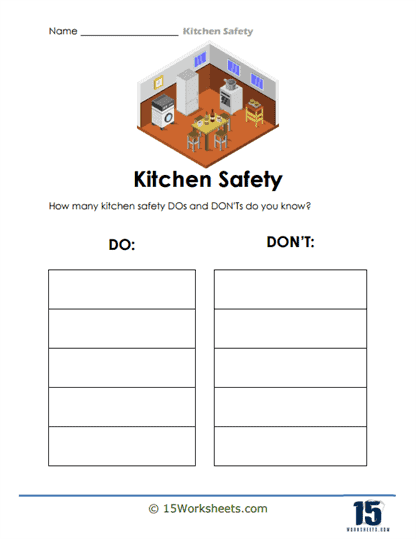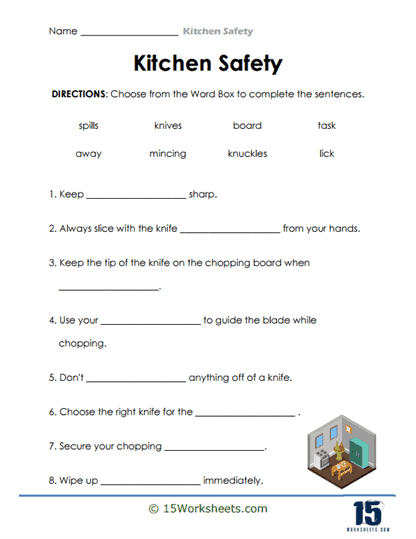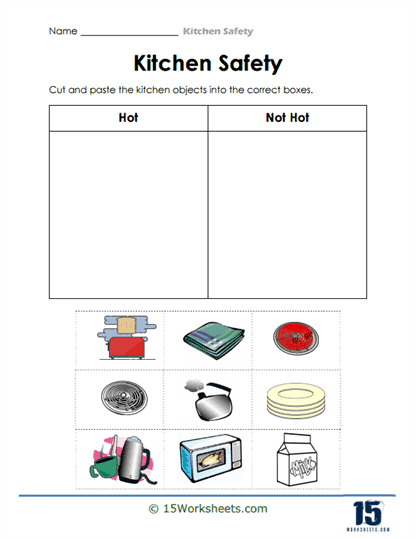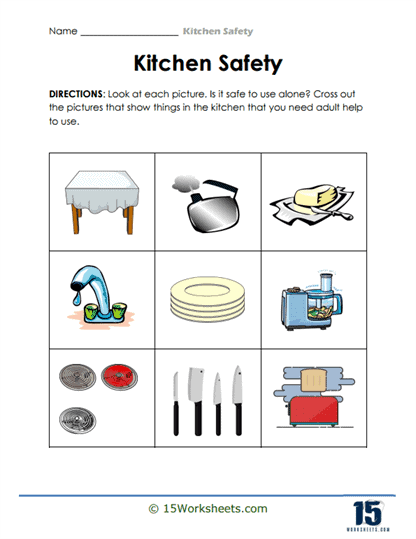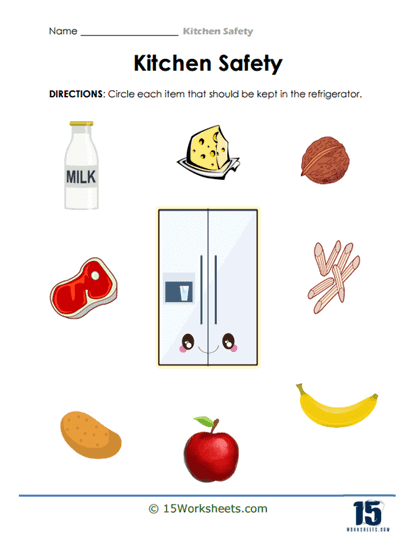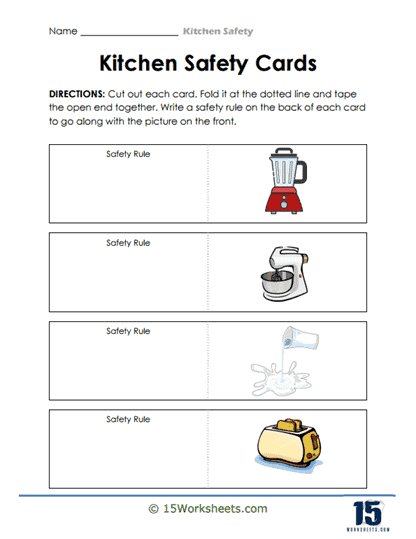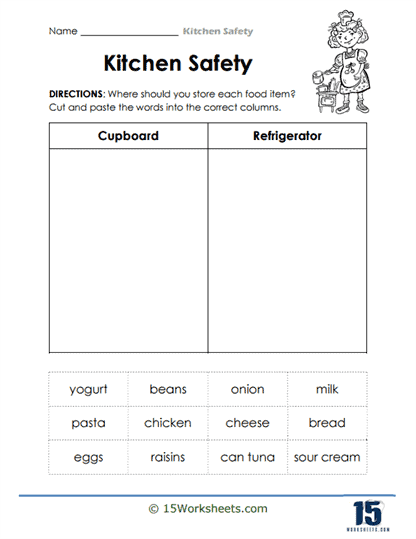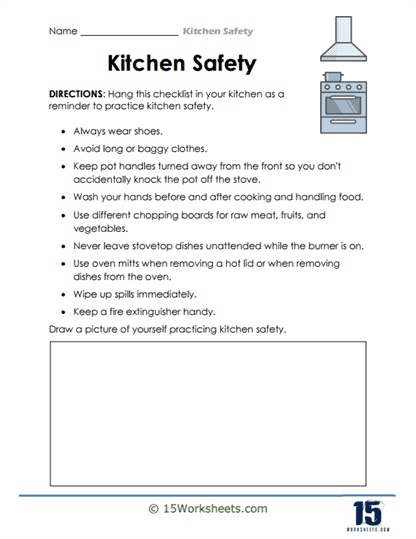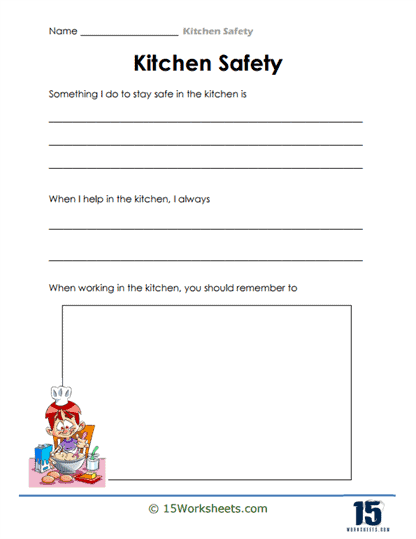Kitchen Safety Worksheets
All About These Worksheets
The collection of worksheets will help you teach students essential skills regarding safe practices in the kitchen. These worksheets focus on increasing awareness of potential hazards, teaching safety rules, and promoting responsible behavior while handling kitchen tasks. The activities presented in the worksheets help students internalize and apply safety guidelines in a hands-on and engaging way.
One key area that the worksheets emphasize is the identification and understanding of common kitchen accidents and how to prevent them. For example, the first worksheet on Common Kitchen Accidents discusses cuts, burns, slips, and choking hazards, giving students important knowledge about potential dangers in the kitchen. It also provides practical tips on how to stay safe, such as using oven mitts and handling knives properly. This encourages children to develop situational awareness and understand that they must be cautious and alert while cooking.
Several worksheets in the collection focus on knife safety, a critical skill for students to master. Worksheets ask students to explain why certain rules are in place, such as keeping knives sharp, slicing away from their hands, and securing the chopping board while cutting. These tasks require students to think critically and reflect on the reasoning behind these safety measures. By doing so, they gain not only theoretical knowledge but also practical application of the safety rules that they can use when helping out in the kitchen.
Other worksheets use a “Do and Don’t” format, where students must determine what behaviors are safe and unsafe. For instance, students are asked to assess whether activities like wearing long, baggy clothes or taking hot items out of the oven with bare hands are safe practices. This activity helps students understand what precautions they should take and reinforces correct safety habits.
There are also worksheets that focus on categorizing objects in the kitchen. For example, students are asked to sort items into categories, such as “sharp” and “not sharp,” or “hot” and “not hot.” These types of cut-and-paste exercises help younger students identify dangerous items in a visual and interactive way. The hands-on aspect of these activities is particularly engaging for children, making learning about safety both fun and memorable.
Another set of worksheets focuses on food safety, where students learn about handling, storing, and preparing food correctly. Students are prompted to answer questions about why certain foods need to be refrigerated quickly or why expiration dates are important. This not only reinforces their understanding of kitchen safety but also gives them a basic understanding of food hygiene, which is crucial for their overall health and well-being.
Overall, this collection of kitchen safety worksheets effectively builds students’ awareness of the hazards they might face in the kitchen and teaches them how to mitigate those risks. By engaging students in both theoretical questions and practical sorting or categorization activities, these worksheets provide a comprehensive learning experience. The variety of tasks helps students develop critical thinking skills while ensuring they internalize important safety protocols that will serve them both in the classroom and in their daily lives.
Types of Exercises on Kitchen Safety Worksheets
Identify the Hazard
One of the most important aspects of kitchen safety is learning to identify potential hazards before they become accidents. Worksheets that focus on this skill often present participants with visual scenarios of a typical kitchen environment, asking them to spot the hazards.
For example, imagine a picture of a stovetop with a pot handle jutting out over the edge. At first glance, this may not seem like a significant issue. However, for someone moving through the kitchen quickly or a child reaching up, this poses a serious risk. By identifying this, the learner becomes more attuned to seemingly minor details that could lead to accidents. This exercise sharpens the participant’s observational skills, training them to be more vigilant and aware in real-life kitchen situations.
In everyday life, this translates to small but crucial changes in behavior. For instance, instead of casually leaving knives near the counter’s edge, individuals will become more mindful of keeping sharp objects out of reach, turning pot handles away from traffic zones, and maintaining a clear workspace. These small actions can make a significant difference in preventing accidents, especially in busy households or environments where children are present.
Safe vs. Unsafe Practices
Another common exercise on kitchen safety worksheets involves comparing safe and unsafe kitchen behaviors. This type of exercise often presents statements or scenarios where participants must determine whether a practice is safe or unsafe.
Consider the statement: “Wearing loose sleeves while cooking.” Although it might seem harmless to some, this practice is highly dangerous, as loose clothing can easily catch fire or knock over items. By categorizing these behaviors, learners not only familiarize themselves with best practices but also begin to internalize what constitutes a risky behavior in the kitchen.
This type of learning is crucial because it helps create a mental checklist for individuals. Over time, they will develop good habits, such as always tying back long hair or rolling up sleeves while cooking. In professional settings, it can help ensure that employees follow stringent safety protocols, thus reducing the risk of accidents in high-paced, high-risk environments.
Emergency Response Scenarios
Knowing what to do in an emergency situation is critical, and worksheets that focus on emergency response can significantly improve a person’s readiness to handle kitchen disasters. These exercises often provide hypothetical scenarios, such as a grease fire erupting on the stove, and ask participants to choose the appropriate response from multiple options.
In this grease fire example, participants would learn that the correct response is to smother the fire with a lid or use a fire extinguisher, rather than attempting to put it out with water, which would exacerbate the fire. This kind of exercise prepares individuals to remain calm and make quick, informed decisions in real-life emergencies, potentially preventing escalation and serious injury.
For everyday application, these exercises can make the difference between panic and poise in critical moments. In a household where a small grease fire breaks out, someone who has practiced these scenarios through worksheets will know immediately what to do, minimizing damage and keeping everyone safe. For professional cooks, being able to act swiftly and correctly in emergencies is part of maintaining a safe kitchen environment.
Tool and Appliance Matching
Kitchen safety isn’t just about emergencies; it’s also about understanding how to use tools and appliances correctly. Worksheets that feature matching exercises, where students must link tools or appliances with their respective safety guidelines, are particularly useful for this purpose.
For instance, participants might be given images of a knife, blender, and oven, and be asked to match them with safety tips such as, “Always cut away from yourself,” or “Never stick your hand inside while the appliance is plugged in.” These exercises ensure that individuals become familiar with each tool’s specific safety requirements, reducing the likelihood of misuse.
In practical terms, this kind of exercise has long-lasting benefits. Someone who has learned to always keep their fingers away from a blender’s blades will carry that habit into their everyday routine, preventing accidents that could result in serious injury. For new cooks or children learning their way around the kitchen, these matching exercises help create a strong foundation of safe practices that will last a lifetime.
Role-Playing Activities
Another powerful exercise often included in kitchen safety worksheets is role-playing. This interactive learning method gives participants the opportunity to act out different kitchen safety scenarios, reinforcing safe behaviors through direct practice.
For example, one student might play the role of a chef demonstrating safe knife usage, while another plays an observer, asking safety-related questions and making suggestions. This allows learners to experience the practical application of safety principles in a controlled, risk-free environment.
In a real-world setting, role-playing exercises can have a profound impact. After practicing scenarios such as safely handling knives or dealing with spills on the floor, participants are more likely to instinctively act correctly when faced with similar situations in their own kitchens.
True or False
True or false quizzes provide a straightforward but effective way to assess and reinforce students’ understanding of kitchen safety principles. Worksheets with statements like, “It’s safe to use water to put out a grease fire” (answer: False) allow learners to test their knowledge and identify areas that might require more attention.
These sheets are particularly useful for self-assessment or for instructors who want to gauge a student’s grasp of kitchen safety. For individuals, taking regular quizzes helps keep important safety facts fresh in their minds, making them more likely to apply these principles when cooking at home or in a professional environment.
The Importance of Kitchen Safety Worksheets
These types of worksheets play a vital role in teaching students essential skills to prevent accidents and injuries. Kitchens contain sharp tools, hot surfaces, and hazardous appliances, so students must learn how to recognize and mitigate these risks. By engaging in activities like identifying hazards and comparing safe versus unsafe practices, students sharpen their awareness of potential dangers in everyday kitchen scenarios. As they work through these exercises, students build habits that help them navigate real-world situations with greater mindfulness, which benefits both novice cooks and professionals.
These worksheets also help students internalize best practices through direct engagement and hands-on application. Activities like role-playing and tool-matching allow students to actively apply their knowledge, reinforcing safety principles in a way that sticks. Younger learners and those with limited kitchen experience gain essential practice that forms a foundation for lifelong safety habits. The interactive approach ensures students not only learn but remember and implement safe behaviors whenever they step into the kitchen.
Kitchen safety worksheets also empower students to handle emergencies with confidence. Exercises that focus on emergency responses train students to act quickly and appropriately when dangerous situations arise. Instead of panicking, students learn to apply the correct measures, such as smothering a grease fire or unplugging faulty appliances. This preparation ensures that students can manage potential hazards and prevent small incidents from becoming major accidents. By mastering these skills, students gain the confidence to handle real-life emergencies with control and precision.

